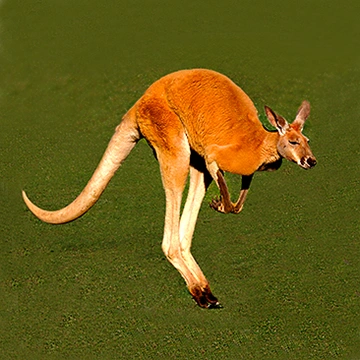Red Kangaroo The Biggest Kangaroo on Earth!

Photo: Red Kangaroo hopping in the Australian Outback
The red kangaroo isn't just the largest kangaroo – it’s the world’s biggest marsupial! This incredible animal can grow up to 2 meters in height, weigh 90 kilograms, and hop at speeds of 60 km/h. With powerful hind legs, a muscular body, and a balancing tail, it’s a true endurance athlete of the Australian Outback. It is a herbivorous marsupial mammal referred to as a macropod.
Male red kangaroos, known as “boomers,” have a striking orange-red coat and muscular build with broad shoulders and strong arms, which often flexing to show dominance or impress females – just like humans showing off at the gym! Females, called “flyers,” are about half the size of the male and usually blue-grey, although in arid regions, they share the male's reddish hue. Both sexes have distinctive square snouts, thick eyelashes, a light-coloured undersides, and black paws and toes. Red kangaroos have a lifespan of 14- 22 years. Its scientific name is Macropus rufus, which means "long red-haired".
Red Kangaroo Behaviour and Social Dynamics
Red kangaroo behaviour is similar to other kangaroos. They live in groups of between 2 to 4 females and their young. Unlike other kangaroos, there’s no strict social structure – they gather where food is abundant. In some cases, mobs can reach up to 1,500 individuals! Despite their laid-back lifestyle, male red kangaroos are the most aggressive of all kangaroo species, engaging in ritualised fighting, known as boxing to assert dominance.
Where Do Red Kangaroos Live?
Photo: Red Kangaroo Habitat Map
Red kangaroos live in arid and semi-arid environments of the Australian Outback. They prefer open plains, scrublands, grasslands, and deserts with sufficient vegetation to provide shade and shelter from the hot sun. Interestingly the areas red kangaroo inhabit have increased since European settlement due to the clearing of large extents of woodland for livestock and agriculture, thus creating new grazing spaces that red kangaroos like.
What Do Red Kangaroos Eat?
Photo: Red Kangaroos Drinking from a farmer's dam
The red kangaroo is a herbivore and its diet consists of grasses, herbs, shrubs and and sometimes fruits and seeds. The red kangaroo uses its large outward projecting front incisor teeth to slice through grass and leaves, and its large molars at the back of its mouth chop and grind its food. They spend nearly half their day grazing. Their two-chambered stomach allows them to ferment and break down tough plant fibres efficiently, extracting maximum nutrients and moisture – enabling them to survive in harsh, dry climates. The red kangaroo extracts most of the water it requires from moisture in the food it eats and can go without drinking for long periods.
Red Kangaroo Reproduction
Photo: Kangaroo baby is only the size of a jellybean
Red kangaroos have one of the most fascinating reproductive systems in the animal kingdom. Females can raise three joeys simultaneously – one outside the pouch but still suckling, another developing inside the pouch, and a third embryo in the womb, whose birth is delayed until conditions are favourable. This remarkable process, known as embryonic diapause, allows them to adapt to the harsh and unpredictable Australian Outback environment.
Red Kangaroo Predators & Threats
Photo: Male Kangaroo muscles
Adult red kangaroos have few natural predators, but their young are vulnerable to eagles, dingoes, foxes, feral cats, and large lizards. Human activities, including road accidents, hunting, and government culling programs, pose the greatest threat. Yet, the population remains stable at around 15 million, and they are classified as “least concern” by the IUCN.
Domestic and wild dogs occasionally attack kangaroos. The kangaroo is a good swimmer and if pursued by a predator, it may flee into waterways, and use its clawed forepaws to grab its assailant and drown it by holding it underwater.
Red Kangaroo Facts
- The red kangaroo is the largest kangaroo.
- It is also the largest marsupial in the world.
- It is also the largest Australian native animal.
- The red kangaroo grows to 2m tall and weighs up to 90kgs.
- It has a top speed of 60kph.
- It can also leap over obstacles 3 meters high.
- The red kangaroo is found in the drier parts of Australia.
- It prefers scrublands, grassland, and desert where there are some trees for shade.
- Its primary diet is grasses. However, it also eats other green vegetation such as forbs and leaves.
- It gets most of the water it requires from moisture in its food it.
- The red kangaroo can go without drinking for long periods of time.
- It minimises its activity during daylight and shelters under vegetation to keep cool.
- The red kangaroo pants (like a dog) to cool its core body temperature, especially its brain.
- It stands with its large tail pulled under its body to shade its tail from the sun.
- The red kangaroo has a larger nasal passage than other types of kangaroo. This to moisten and cool the hot air it breathes in.
- It is mainly active at dawn, dusk and into the night.
- However, red kangaroos sometimes move about during the day.
- Like other kangaroos, the red kangaroo sweats only while moving. It also spreads saliva on its forearms to cool itself.
- Fighting between males is called boxing.
- An adult female kangaroo is always pregnant.
- Red kangaroos live in groups of 2–4 members.
- An adult kangaroo has no significant predators.
- It is too big and too fast for both native and introduced predators.
- Young kangaroos fall prey to dingoes and eagles.
- Red kangaroos live 14- 22 years.